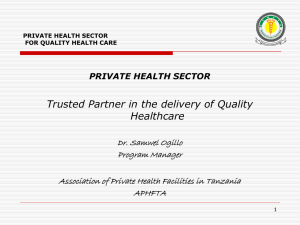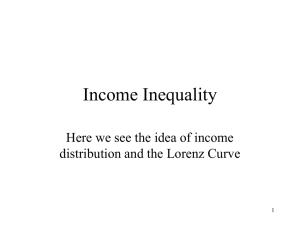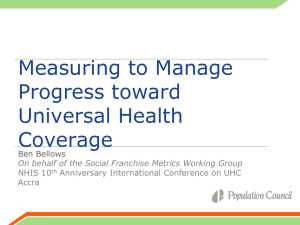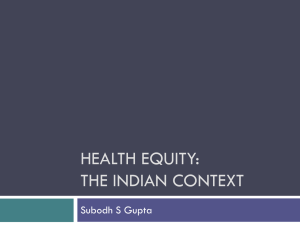usaid-health-equity-pres-07-12-2012
advertisement
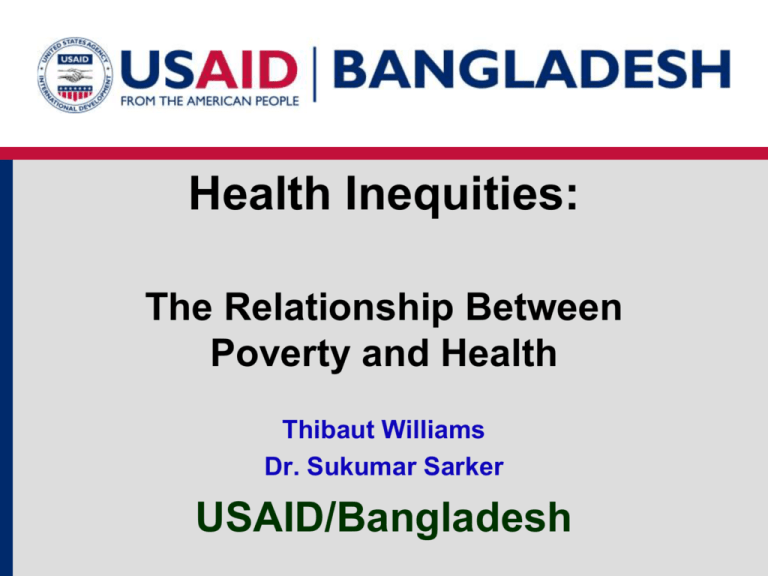
Health Inequities: The Relationship Between Poverty and Health Thibaut Williams Dr. Sukumar Sarker USAID/Bangladesh Global Health Inequities • Nearly 1,000 women die each day from preventable causes – 99 percent of these deaths occur in the developing world • 80 percent of child deaths occur in SubSaharan Africa and South Asia • In most countries these gaps are widening Health Inequities within Countries • Poorest quintile (20%) of women in developing countries are 2-3 times less likely to have access to maternal health services than those in the wealthiest quintile • In Peru, MMR is 6x higher in the poorest quintile than in the wealthiest quintile • Health inequities are larger in countries with: – Overall lower levels of health care – Higher rates of poverty – Weaker governance Inequity vs. Inequality • Health Inequality refers to differences in health status or access • Health Inequities refer to systematic, unjust inequalities • In Narrowing the Gap to Meet the Goals, UNICEF states that an equity-focus child survival and development approach is the most cost-effective and practical way of meeting the MDGs Other Factors Affecting Health Inequity • Demographics – Age – Parity – Educational status • Place of Residence – Urban – Rual • • • • Ethnicity Caste Age Stigmatized Groups (e.g., female sex workers) Inequities by Types of Service • Inequities disproportionately affect maternal health services – More costly and require more specialized care than other basic primary health services – Tanzania: avg distance traveled for basic medical care is 7-8km vs 28km for delivery services – Normal deliveries can account up to 26% of annual income for poor women, while severe complications consume on average 90-138% Health Inequities in Bangladesh Inequities in Maternal Health Services in Bangladesh • The poorest 20% of women are: – Nearly 3x less likely to have received ANC – Nearly 6x less likely to have a skilled attendant at birth • The poorest 20% of children are: – >2x to be stunted (HFA) – >2x to be underweight (WFA) – nearly 3x less likely to be fed correctly (6-23 months) Source: BDHS 2011 The Pathway from Poverty to Poor Health – the Supply Side • Inequitable financial and human resource allocations • Inadequate infrastructure (e.g., health facilities, roads, bridges) • Poorer quality of care • Less outreach services • Poorer care giving behaviors to less educated and less wealthy clients The Pathway from Poverty to Poor Health – the Demand Side • Financial barriers – Cost of services – Informal fees – Indirect costs (e.g., transportation, time lost) • Cultural beliefs and practices • Gender imbalances • Differences in education The Pathway from Poverty to Poor Health – Contextual Factors • Poor generally lack access to: – – – – – Safe water Sanitation Adequate housing Education Adequate quality & quantity of food • Environmental pollution • Poor infrastructure • Unsafe living conditions (e.g., violence, road accidents How to Target the Poor • Individual/Household targeting – Means testing (e.g., income, consumption) – Proxy means testing (e.g., asset ownership) – Community-based/Participatory targeting • Categorical Targeting – Demographics (e.g., sex, age, parity) – Geographical • Self-Targeting Challenges in Targeting • Trade-off between costs/benefits of targeting • Data either unavailable, of poor quality, insufficiently disaggregated, or underreported • Errors of inclusion (i.e., leakage) and exclusion • “Paradox of Targeting” • Stigma • Large informal sector or poor population How to Better Serve the Poor - I • Health financing approaches (e.g., social insurance, removing user fees, sliding scale fee structures, conditional cash transfers, subsidies, vouchers/waivers for particular services) • Allocations of financial, human and material resources prioritizing low performing areas/groups • Task-shifting/sharing to increase access for poor groups How to Better Serve the Poor - II • Infrastructural improvements (e.g., health facilities, roads, maternity waiting homes) • Expanded outreach services (e.g., satellite/mobile clinics, community-based health workers) • Addressing the social determinants of health (e.g., gender, education, economic strengthening) How to Better Serve the Poor-III • Health system strengthening (e.g., quality improvement, improved governance, attitudes of care givers) • Increased community participation to increase access/acceptance and improve cost-effectiveness • Use of technology to reduce access barriers for information and services • Public-private partnerships to introduce new technology, to improve quality and options of care What are we doing in Bangladesh? Bangladesh Experiences Expanded Outreach Services / Community Participation • Vaccination outreach (EPI sites, NID) – Community offered premises (makeshift) • Community IMCI (Diarrhea and ARI management) – Community health workers – Volunteers • Satellite clinics for ANC, PNC, and FP services • Community offered premises – Support group • Community clinics – Clinic management group – Support group – Donated sites Expanded Outreach Services / Community Participation • Community based safe motherhood and newborn care services (MaMoni project) – Community action group (micro-planning at community level) – Union coordination meeting (problem solving and ensuring support) • Fistula repair and rehabilitation (Fistula Care) – Community awareness – Community support for rehabilitation Health Financing Approaches • Demand side financing (DSF) for maternal health • Reimbursement payment for permanent FP methods • SSFP safety net for the poor Infrastructural Improvements • • • • • • • • EmOC centers in Upazila Health Complex Upgradation of Upazila Health Complexes Upgradation of Union Family Welfare Centers Community Clinic: New tier of static health centers Urban primary health care centers (UPHCP) Vaccine storage capacity (GAVI) Increased capacity in district hospitals Addition of tertiary level facilities (new medical college hospitals and specialized hospitals) Allocation of Financial Resources • Subsidized contraceptives in private market (Social marketing) • Expanded DOTS services for TB (Global Fund) • Community based management of MDR TB- support for nutritional supplements • Targeted HIV prevention interventions for the most at risk population (female sex workers, MSMs and Transgenders, IDUs, and PLHAs) Inequity exists • Vaccination coverage for all basic vaccines – Lowest wealth quintile: 76.8% – Highest wealth quintile: 93.5% • Diarrhea and ARI management – Treatment sough for ARI • Lowest wealth quintile: 25% • Highest wealth quintile: 60% – Treatment sought for diarrhea • Lowest wealth quintile: 9.5% • Highest wealth quintile: 49.5% Inequity exists • Maternal Health services – Received any ANC • Lowest wealth quintile: 48% • Highest wealth quintile: 93% – Facility delivery • Lowest wealth quintile: 10% • Highest wealth quintile: 60% – Delivery by trained provider • Lowest wealth quintile: 12% • Highest wealth quintile: 64% Inequity exists • Severe malnutrition (Weight for age) – Lowest wealth quintile: 16.6% – Highest wealth quintile: 4% • Infant and young child feeding practices (4+ food groups among all children 6-23 months) – Lowest wealth quintile: 13% – Highest wealth quintile: 37.6% • Vitamin A supplementation – Lowest wealth quintile: 55% – Highest wealth quintile: 62% Inequity exists • Knowledge of AIDS Women Men Lowest wealth quintile: 43% Lowest wealth quintile: 71% Highest wealth quintile: 93% Highest wealth quintile: 99% • Knowledge of HIV Prevention (Condom and Faithfulness) Women Men Lowest wealth quintile: 21% Lowest wealth quintile: 45% Highest wealth quintile: 58% Highest wealth quintile: 71% How to reduce the existing gap? What additional equity-focused approaches we need to implement? • • • • Health systems strengthening? Participatory planning? Demand generation and BCC? Financial support for utilization of services?
